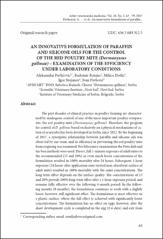An innovative formulation of paraffin and silicone oils for the control of the red poultry mite (Dermanyssus gallinae) - examination of the efficiency under laboratory conditions

View/
Date
2017Author
Pavlićević, Aleksandar
Ratajac, Radomir
Dotlić, Milica
Stojanov, Igor
Pavlović, Ivan
Metadata
Show full item recordAbstract
The past decades of clinical practice in poultry farming are characterized by inadequate control of one of the most important poultry ectoparasite, the red poultry mite (Dermanyssus gallinae). Therefore, the program for control of D. gallinae based exclusively on a physical mechanisms of action of acaricides has been developed in Serbia since 2012. By the beginning of 2017, a synergistic relationship between paraffin and silicone oils was observed by our team, and its efficiency in preventing the red poultry mite from respiring was examined. For laboratory examination the Petri dish and tin-box methods were used. Direct, full 1-minute exposure of adult mites to the recommended (15 and 20%) or even much lower concentration of the formulation resulted in 100% mortality aft er 24 hours. Subsequent 1-hour exposure (24 hours aft er application onto treated non-absorbent surface of adult mite) resulted in 100% mortality with the same concentrations. The long term eff ect depends on the surface quality. The concentrations of 15 and 20% provide 100% long-term effect after a 1-hour exposure period, and remains fully effective over the following 4-month period. In the following months (8 months), the formulation continues to work with a slightly lesser, however, still significant effect. The formulation is most effective on a plastic surface, where the full effect is achieved with significantly lower concentrations. The formulation has no effect on eggs; however, after the short development cycle is completed in the egg (2-6 days) and exit from the shell, the larva is immediately exposed to the eff ects of the formulation and eliminated. High efficiency of the paraffin and silicone oils formulation, which has been established in laboratory conditions, justifies its use to the purpose of D. gallinae control in cages and equipment before flock settlement as well as in transport cages aft er cleaning and disinfection.
